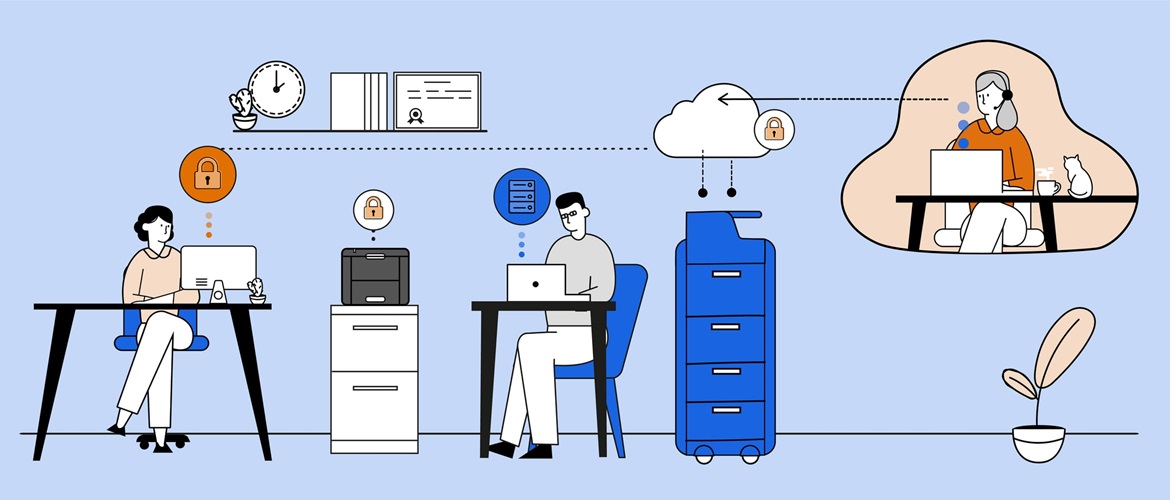
Cloud vs on-premise software: The pros and cons
As hybrid working rapidly becomes the norm and with more employees working remotely than ever, IT departments are facing some key questions.
For example, accessing documents, data and software from remote locations can introduce security risks. Meanwhile, ensuring remote and location independent workers have the software they require can present technical complexities.
A common solution to these problems is to transition from on-premise software and storage over to cloud based services. But is cloud software right for your organisation? To help you decide, here we give you an overview of the pros and cons of traditional on-premise software versus newer cloud software solutions.
The pros and cons of on-premise software
On-premise software is the more traditional model of making software available to employees. The software is managed by a dedicated in-house department and manually installed on employees’ work devices.
The pros of on-premise software
- Lower long-term software purchasing costs: Buying software licenses may be more cost effective over the long term than purchasing recurring cloud-based software subscriptions.
- No internet connection required: Employees won’t need an internet connection to access and use on-premise software.
- Customisation options: Software managed on-premise may often be more customisable than software delivered from a cloud service.
- On-premise security: Software and documents stored on on-premise servers accessed by on-premise can potentially be more secure than cloud servers.
The cons of on-premise software
- Resource intensive installation: Installing software manually on employees’ computers can be time consuming and expensive. This is especially the case where employee hardware isn’t standardised and individual installations can become complex.
- Resource intensive and expensive management: Internal employees must manage on-premise software, and will require in-house infrastructure, such as dedicated servers.
- The complexity of hybrid working: If an organisation has multiple premises plus employees working at remote locations, it can pose significant challenges when it comes to installing and managing employees’ software.
The pros and cons of cloud software
Cloud software is stored and managed off-site by a third-party. Rather than having the software installed on a single computer, employees can access the software they need through a web connection.
The pros of cloud software
- Lower initial costs: Cloud software paid for as a recurring subscription will be cheaper up-front than purchasing a large number of software licences.
- Speed and ease of deployment: Cloud delivery removes the need for installing software manually on employee’s computers, which can be time-consuming. Employees will be able to use cloud software almost instantaneously.
- Ease of switching to new software: Software can go out-of-date and be superseded by alternative software over time. Manually removing old software and installing new versions on employees’ computers will be resource intensive and complicated to manage.
- Ease of access: One of the greatest benefits of cloud software is that it can be accessed from any location. Employees will be able to log-in from a range of networked devices from remote locations without even needing a dedicated work computer.
- A simplified managed service: In-house software can require substantial management, including handling updates and security patches, plus managing supporting hardware, such as servers and data storage. With cloud software, your organisation is purchasing a professional service which handles all aspects of software management for you. You can think of this as outsourcing business functions to external experts.
The cons of cloud software
- Higher long-term costs: Cloud software subscription costs may be more expensive over time than purchasing software licenses.
- Less options for customisation: Cloud-based software can be less customisable than software managed in-house.
Whilst there may be higher subscription costs associated with cloud-based software, this is often more than offset by the costs saved in installing and managing on-premise software. Many organisations are finding that cloud software offers considerable advantages when it comes to availability and ease of access in off-site locations, making cloud-based options ideal for businesses that offer hybrid working.
Find out more about how Brother can help your organisation successfully adapt to hybrid working. We offer a range of hybrid solutions, including our Brother Cloud Apps that allow your documents to be accessed directly through selected Brother devices without needing a computer.
Sources
https://www.morefield.com/blog/on-premises-vs-cloud/
https://www.empowersuite.com/en/blog/on-premise-vs-cloud



